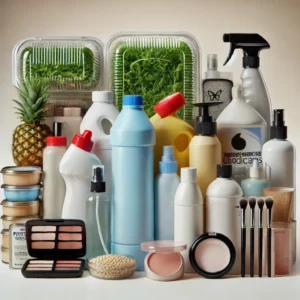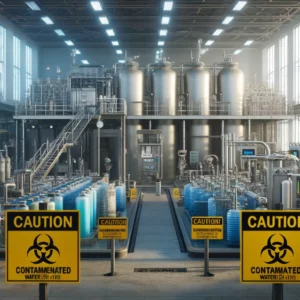Medical Toxicologists Identify Six Everyday Items Linked to Chronic Health Conditions
Medical toxicologists at leading U.S. healthcare institutions have identified six everyday household products that could pose serious health risks through regular use. Dr. Peter Chai from Brigham and Women’s Hospital and Dr. Natasha Bhuyan from One Medical reveal that products ranging from nonstick cookware to scented dryer sheets contain compounds linked to cancer, hormonal disruption, and reproductive issues. These toxic exposures often occur gradually through repeated contact, making their effects challenging to detect until health problems emerge. Their findings highlight the need for consumers to reevaluate everyday household items and consider safer alternatives.
5 Key Points
- 79% of nonstick pans tested contain potentially carcinogenic PFAS chemicals.
- Scented candles can emit formaldehyde at levels exceeding 2,000 parts per billion.
- Plastic food containers release BPA, disrupting hormonal systems.
- Vintage tableware manufactured before the 1970s may contain dangerous lead levels.
- Standard dryer sheets include toxic compounds like benzyl acetate and chloroform.
Nonstick Cookware Releases “Forever Chemicals”
Nonstick pans are among the household items, with research showing that 79% contain polyfluorinated compounds (PFAS) or polytetrafluoroethylene (PTFE). Dr. Natasha Bhuyan, Vice President of In-Office Care at One Medical, explains that these pans release PTFE particles when scratched or heated to high temperatures. “People who use those regularly are consuming many different foods with PTFE particles, which has been linked to kidney cancers, thyroid cancers, and ovarian cancers,” she warns. Medical experts recommend replacing nonstick cookware with cast iron or ceramic alternatives to minimize exposure risks.
Scented Candles Emit Harmful Compounds
The chemical reaction from burning scented candles produces volatile organic compounds (VOCs), including benzene and toluene. A 2015 study revealed that a single strawberry-scented candle emitted formaldehyde at 2,098 parts per billion, far exceeding safety thresholds. While Dr. Peter Chai maintains that candles remain safe for those without fragrance allergies, Dr. Bhuyan points to emerging research linking VOCs to reproductive health issues. She recommends using pure essential oils as an alternative while cautioning consumers to choose brands without added ingredients.
Dryer Sheet Chemicals Pose Respiratory Risks
Standard dryer sheets contain toxic substances, including benzyl acetate, ethanol, and chloroform. The Environmental Working Group has documented how these scented laundry products contaminate indoor air quality. “In the short term, we see people who have allergic reactions or skin irritations to certain dryer sheets,” Dr. Bhuyan notes, adding that chemical exposure can trigger asthma symptoms. Wool dryer balls offer a safer alternative for softening clothes and removing lint.
Pesticide Residue Threatens Produce Safety
The Environmental Working Group’s “Dirty Dozen” list highlights fruits and vegetables most contaminated by pesticides, including spinach, apples, nectarines, green beans, and strawberries. According to EPA data, these chemicals can affect the nervous and endocrine systems and may contain carcinogens. Dr. Bhuyan recommends thorough cleaning: “Rinsing with water is fine, but it doesn’t always remove all of the pesticides. You need to actually scrub it with your hands, or another alternative is soaking it in water with a bit of baking soda for one minute.”
Plastic Containers Leach Hormone-Disrupting Chemicals
Since the 1950s, plastic containers have incorporated Bisphenol A (BPA), an industrial chemical that interferes with hormone function. “What we’re finding in the research is that [BPA] can either act like a hormone or it changes the way hormones impact our system,” Dr. Bhuyan explains. Long-term exposure correlates with early puberty in girls, fertility problems, and elevated blood pressure. The Mayo Clinic confirms that heating these containers accelerates chemical transfer into food, making glass containers safer.
Vintage Tableware Contains Lead Hazards
Despite the 1970s federal ban on lead paint in commercial products, vintage plates, and serving dishes may still harbor this dangerous chemical. Lead exposure can damage the brain and vital organs, while children face additional risks of developmental delays and learning disabilities. The FDA recommends testing older tableware with commercially available lead detection kits before use.
FAQ
Q: How can I tell if my nonstick pans are releasing toxic chemicals?
A: Look for visible scratches on the pan’s surface. However, even micro-scratches invisible to the naked eye can leak PFAS chemicals. Dr. Bhuyan recommends replacing scratched nonstick pans with cast iron or ceramic alternatives, regardless of their apparent condition.
Q: Are all scented candles toxic, or just certain types?
A: While research shows mixed results, scented candles can emit volatile organic compounds (VOCs), including benzene and toluene. A 2015 study found that strawberry-scented candles released formaldehyde at concerning levels. Dr. Chai notes that candles remain safe for those without fragrance sensitivities, but pure essential oils offer a potentially safer alternative.
Q: What’s the most effective way to remove pesticides from fruits and vegetables?
A: Dr. Bhuyan recommends two methods: either thoroughly scrubbing produce by hand under running water or soaking items in water mixed with baking soda for one minute. Simple rinsing alone may not remove all pesticide residues.
Q: How do I know if my plastic containers contain BPA?
A: Most plastic containers manufactured since the 1950s contain BPA. The Mayo Clinic explicitly warns against heating food in plastic containers, as this accelerates chemical transfer. Glass containers provide the safest food storage and reheating alternative.
Q: Can I safely use vintage dishes if I don’t heat food in them?
A: The FDA advises testing all vintage tableware manufactured before the 1970s federal lead ban for lead content, regardless of intended use. Lead test kits are available at hardware stores. Even without heating, lead can leach into food from contaminated dishes.
Q: What immediate symptoms might indicate exposure to household toxins?
A: Dr. Bhuyan identifies several short-term symptoms, including throat irritation, dizziness, headaches, skin irritation, and allergic reactions. Some people may experience respiratory issues like asthma symptoms from exposure to scented products.
Citations
McPhillips, Kells (December 13, 2024). These 6 common household products may be making Americans sick, a toxicologist warns. https://www.msn.com/en-us/health/other/these-6-common-household-products-may-be-making-americans-sick-a-toxicologist-warns/ar-AA1vOthH?ocid=msedgntp&pc=ASTS&cvid=2fb3a7171845446d8f4c74b31e2de6d2&ei=73These 6 common household products may be making Americans sick, a toxicologist warns







